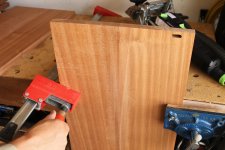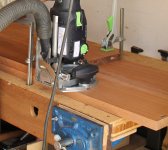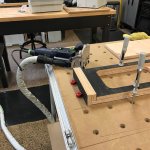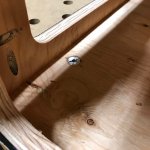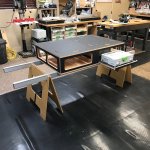Do I need the Seneca Imperial thickness gauge for the Domino 500 (just got a great deal on one, should be here in a few days). For the first project I plan on using it for, I'm making built ins using 3/4 material (3/4 ply and 1x boards). Or should I look at the Seneca Domiplate? Any other suggestions for the Domino?
You are using an out of date browser. It may not display this or other websites correctly.
You should upgrade or use an alternative browser.
You should upgrade or use an alternative browser.
New to the domino 500
- Thread starter ColossusX
- Start date
DynaGlide
Member
- Joined
- May 16, 2017
- Messages
- 1,697
You don't need either to do what you want. The Domiplate is a 'nice to have' for giving you a more solid way to hold the Domino in some situations. The dominos themselves don't need to be centered in the stock which is what the Domiplate does. Play around with it on scrap for a while. I don't use mine often so I have to re-learn it each time I get it out.
I agree with [member=65062]DynaGlide[/member] ... try it out and get use to it before purchasing accessories .. you can do everything without them. Here's a link to a video explaining one method on how to cut Dominos for casework. I've been using this method for a while and really like it. Good luck.
ear3
Member
Imperial thickness gauge is just a super expensive piece of plastic in most situations, and only truly useful in my experience if you need to do precise offsets in multiple pieces of wood of different thicknesses (and don't want or don't have the patience to do the metric/imperial conversion in your head).
The Domino plate however I consider for myself to be a must-have -- and nort just for the centering capabilities on nominal plywood (and as already mentioned, you don't have to be dead on center for a domino joint to work), but also because of how it facilitates vertical plunging. You get a stabilizing attachment with the machine that performs the same function, but since the fence is down during the plunge, you still don't get the amount of surface area support enabled by the Domino plate.
The Domino plate however I consider for myself to be a must-have -- and nort just for the centering capabilities on nominal plywood (and as already mentioned, you don't have to be dead on center for a domino joint to work), but also because of how it facilitates vertical plunging. You get a stabilizing attachment with the machine that performs the same function, but since the fence is down during the plunge, you still don't get the amount of surface area support enabled by the Domino plate.
GoingMyWay
Member
I bought a reconditioned DF500 a while back, but only recently started playing around with it trying to make test cuts in scrap 3/4" material. I didn't realize that the vertical plunges can be a little tricky.
I watched Peter Millard's Domino series (https://youtu.be/OJaVpnCfcLc?t=133) and he convinced me to buy the Domiplate. I bought the last one that was being sold on Amazon. It's going to arrive tomorrow.
Peter mentioned in the video that it's easy enough to make your own Domiplate yourself out of plywood if you're not concerned with trying to try center the Domino. I'm not concerned about the centering, but I personally just prefer to buy something ready to go off the shelf that I know works.
I watched Peter Millard's Domino series (https://youtu.be/OJaVpnCfcLc?t=133) and he convinced me to buy the Domiplate. I bought the last one that was being sold on Amazon. It's going to arrive tomorrow.
Peter mentioned in the video that it's easy enough to make your own Domiplate yourself out of plywood if you're not concerned with trying to try center the Domino. I'm not concerned about the centering, but I personally just prefer to buy something ready to go off the shelf that I know works.
GoingMyWay said:Snip.
I watched Peter Millard's Domino series (https://youtu.be/OJaVpnCfcLc?t=133) .
When used with the base support bracket, I do not hold the DF500 vertically in the way that Peter shows at 2:55 or so. Instead of laying the board flat on the bench, I clamp the board vertically in the vise, and use the DF 500 with the support bracket horizontally, the same way the DF500 is used to mortise end grain. In other words, the plunging is done horizontally (which is easier to do), not vertically.
The only time I plunge vertically is when I mortise for shelves (second image).
Attachments
[member=63307]TrackTubesGuy[/member] I liked the video. But newbie question. When using the dominos for casework like he did, is there a need for mechanical fasteners? Or just the dominos and glue?
And thanks for the input everyone. I'll work with it by itself and look at the plate in the future
And thanks for the input everyone. I'll work with it by itself and look at the plate in the future
GoingMyWay
Member
ChuckM said:When used with the base support bracket, I do not hold the DF500 vertically in the way that Peter shows at 2:55 or so. Instead of laying the board flat on the bench, I clamp the board vertically in the vise, and use the DF 500 with the support bracket horizontally, the same way the DF500 is used to mortise end grain. In other words, the plunging is done horizontally (which is easier to do), not vertically.
The only time I plunge vertically is when I mortise for shelves (second image).
I hadn't thought about doing a shelf in the middle like that! I guess the Domiplate won't work for that.
Like anything, there is more than one way to skin a cat and I guess it also depends on the specific type of work you're doing and your workflow. Thanks for sharing your technique!
As I was saying, I'm literally messing around just cutting mortises in little scraps of plywood to see how the alignment and fit works. I haven't even been thinking about real world applications i.e. making a 4 sided box that needs to fit together.
A word of caution: when using the casework jig method, make sure you cut the new jig based on the plywood material you use each time, or at least double check the jig's thickness is the same as that of the material you will be using. Ply sheets are not always in the same thickness even when sold by the same vendor.
I mill rough lumber myself, and always cut a new strip jig as the thickness planer does not necessarily produce stock of the same thickness from one project to another.
I mill rough lumber myself, and always cut a new strip jig as the thickness planer does not necessarily produce stock of the same thickness from one project to another.
ColossusX said:[member=63307]TrackTubesGuy[/member] I liked the video. But newbie question. When using the dominos for casework like he did, is there a need for mechanical fasteners? Or just the dominos and glue?
And thanks for the input everyone. I'll work with it by itself and look at the plate in the future
Most the time you can just use dominos and glue, but it really depends on what you're putting together, and how it goes together ... I've done it all 3 ways 1.) domino/glue only 2.) domino/glue/mechanical fastener 3.) domino/mechanical fastener only
The project I was working on this past weekend I only used dominos and a couple pocket screws because I wanted to be able to break it down if necessary. For a more permanent assembly I would have used glue also.
And like [member=57948]ChuckM[/member] mentioned, if you're using the method shown in the video, make sure you use off-cuts of the same material as being used in your project because thicknesses do vary.
Attachments
Domino and glue works fine with wood when you don't want to be able to flatpack it, you'll need some good clamps (I can suggest Bessey REVO) to press the seams till they're dry though so the connection is as stable as possible.ColossusX said:[member=63307]TrackTubesGuy[/member] I liked the video. But newbie question. When using the dominos for casework like he did, is there a need for mechanical fasteners? Or just the dominos and glue?
Stuff like HPL coated particle board dosn't glue that good, you'll need screws/fasteners to hold it together - or strip the coating (eg. with a router) in the places where you want to glue.
The Festool 8mm connectors work well when you want to be able to disassemble/flatpack - unless you want to invest into a Lamello Zeta (where the connectors can be fully hidden).
Similar threads
- Replies
- 23
- Views
- 908
- Replies
- 6
- Views
- 277

